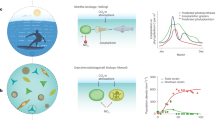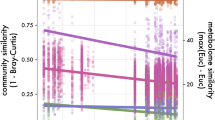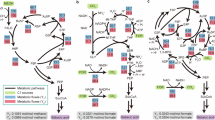Abstract
Metabolic specialization is a general biological principle that shapes the assembly of microbial communities. Individual cell types rarely metabolize a wide range of substrates within their environment. Instead, different cell types often specialize at metabolizing only subsets of the available substrates. What is the advantage of metabolizing subsets of the available substrates rather than all of them? In this perspective piece, we argue that biochemical conflicts between different metabolic processes can promote metabolic specialization and that a better understanding of these conflicts is therefore important for revealing the general principles and rules that govern the assembly of microbial communities. We first discuss three types of biochemical conflicts that could promote metabolic specialization. Next, we demonstrate how knowledge about the consequences of biochemical conflicts can be used to predict whether different metabolic processes are likely to be performed by the same cell type or by different cell types. We then discuss the major challenges in identifying and assessing biochemical conflicts between different metabolic processes and propose several approaches for their measurement. Finally, we argue that a deeper understanding of the biochemical causes of metabolic specialization could serve as a foundation for the field of synthetic ecology, where the objective would be to rationally engineer the assembly of a microbial community to perform a desired biotransformation.
Similar content being viewed by others
Log in or create a free account to read this content
Gain free access to this article, as well as selected content from this journal and more on nature.com
or
References
Aharoni A, Gaidukov L, Khersonsky O, Gould SM, Roodveldt C, Tawfik DS . (2005). The ‘evolvability’ of promiscuous protein functions. Nat Genet 37: 73–76.
Aziz RK, Bartels D, Best AA, DeJongh M, Disz T, Edwards RA et al. (2008). The RAST server: rapid annotations using subsystems technology. BMC Genomics 9: 75.
Barrick JE, Yu DS, Yoon SH, Jeong H, Oh TK, Schneider D et al. (2009). Genome evolution and adaptation in a long-term experiment with Escherichia coli. Nature 461: 1243–1247.
Beg QK, Vazquez A, Ernst J, de Menezes MA, Bar-Joseph Z, Barabasi AL et al. (2007). Intracellular crowding defines the mode and sequence of substrate uptake by Escherichia coli and constrains its metabolic activity. Proc Natl Acad Sci USA 104: 12663–12668.
Cooper VS, Lenski RE . (2000). The population genetics of ecological specialization in evolving Escherichia coli populations. Nature 407: 736–739.
Costa E, Perez J, Kreft JU . (2006). Why is metabolic labour divided in nitrification? Trends Microbiol 14: 213–219.
Curtis TP, Sloan WT, Scannell JW . (2002). Estimating prokaryotic diversity and its limits. Proc Natl Acad Sci USA 99: 10494–10499.
De Souza ML, Newcombe D, Alvey S, Crowley DE, Hay A, Sadowsky MJ et al. (1998). Molecular basis of a bacterial consortium: Interspecies catabolism of atrazine. Appl Environ Microbiol 64: 178–184.
Dekel E, Alon U . (2005). Optimality and evolutionary tuning of the expression level of a protein. Nature 436: 588–592.
Doebeli M . (2002). A model for the evolutionary dynamics of cross-feeding polymorphisms in microorganisms. Popul Ecol 44: 59–70.
Doebeli M, Ispolatov I . (2010). Complexity and diversity. Science 328: 494–497.
Dunham MJ . (2007). Synthetic ecology: a model system for cooperation. Proc Natl Acad Sci USA 104: 1741–1742.
Eisen JA . (2007). Environmental shotgun sequencing: its potential and challenges for studying the hidden world of microbes. PLoS Biol 5: e82.
Elena SF, Lenski RE . (2003). Evolution experiments with microorganisms: The dynamics and genetic bases of adaptation. Nat Rev Genet 4: 457–469.
Fay P . (1992). Oxygen relations of nitrogen-fixation in cyanobacteria. Microbiol Rev 56: 340–373.
Ferenci T . (2005). Maintaining a healthy SPANC balance through regulatory and mutational adaptation. Mol Microbiol 57: 1–8.
Gans J, Wolinsky M, Dunbar J . (2005). Computational improvements reveal great bacterial diversity and high metal toxicity in soil. Science 309: 1387–1390.
Gruber TM, Gross CA . (2003). Multiple sigma subunits and the partitioning of bacterial transcription space. Annu Rev Microbiol 57: 441–466.
Gudelj I, Beardmore RE, Arkin SS, Maclean RC . (2007). Constraints on microbial metabolism drive evolutionary diversification in homogeneous environments. J Evol Biol 20: 1882–1889.
Gudelj I, Weitz JS, Ferenci T, Horner-Devine MC, Marx CJ, Meyer JR et al. (2010). An integrative approach to understanding microbial diversity: from intracellular mechanisms to community structure. Ecol Lett 13: 1073–1084.
Herring CD, Raghunathan A, Honisch C, Patel T, Applebee MK, Joyce AR et al. (2006). Comparative genome sequencing of Escherichia coli allows observation of bacterial evolution on a laboratory timescale. Nat Genet 38: 1406–1412.
Huber JA, Mark Welch D, Morrison HG, Huse SM, Neal PR, Butterfield DA et al. (2007). Microbial population structures in the deep marine biosphere. Science 318: 97–100.
Ibarra RU, Edwards JS, Palsson BO . (2002). Escherichia coli K-12 undergoes adaptive evolution to achieve in silico predicted optimal growth. Nature 420: 186–189.
Jessup CM, Kassen R, Forde SE, Kerr B, Buckling A, Rainey PB et al. (2004). Big questions, small worlds: microbial model systems in ecology. Trends Ecol Evol 19: 189–197.
Kassen R, Rainey PB . (2004). The ecology and genetics of microbial diversity. Annu Rev Microbiol 58: 207–231.
Kato S, Haruta S, Cui ZJ, Ishii M, Igarashi Y . (2005). Stable coexistence of five bacterial strains as a cellulose-degrading community. Appl Environ Microbiol 71: 7099–7106.
Khan AI, Dinh DM, Schneider D, Lenski RE, Cooper TF . (2011). Negative epistasis between beneficial mutations in an evolving bacterial population. Science 332: 1193–1196.
Le Gac M, Doebeli M . (2010). Epistasis and frequency dependence influence the fitness of an adaptive mutation in a diversifying lineage. Mol Ecol 19: 2430–2438.
MacLean RC, Gudelj I . (2006). Resource competition and social conflict in experimental populations of yeast. Nature 441: 498–501.
Markowitz VM, Korzeniewski F, Palaniappan K, Szeto E, Werner G, Padki A et al. (2006). The integrated microbial genomes (IMG) system. Nucleic Acids Res 34: D344–D348.
Pease CM, Bull JJ . (1988). A critique of methods for measuring life-history trade-offs. J Evol Biol 1: 293–303.
Pelz O, Tesar M, Wittich RM, Moore ERB, Timmis KN, Abraham WR . (1999). Towards elucidation of microbial community metabolic pathways: unravelling the network of carbon sharing in a pollutant-degrading bacterial consortium by immunocapture and isotopic ratio mass spectrometry. Environ Microbiol 1: 167–174.
Pfeiffer T, Bonhoeffer S . (2004). Evolution of cross-feeding in microbial populations. Am Nat 163: E126–E135.
Rambaud JC, Buts JP, Corthier G, Flourie B . (2006) Gut Microflora: Digestive Physiology and Pathology. John Libbey Eurotext: Paris.
Ro DK, Paradise EM, Ouellet M, Fisher KJ, Newman KL, Ndungu JM et al. (2006). Production of the antimalarial drug precursor artemisinic acid in engineered yeast. Nature 440: 940–943.
Saier MH . (2000). Families of transmembrane sugar transport proteins. Mol Microbiol 35: 699–710.
Scott M, Gunderson CW, Mateescu EM, Zhang ZG, Hwa T . (2010). Interdependence of cell growth and gene expression: origins and consequences. Science 330: 1099–1102.
Travisano M, Mongold JA, Bennett AF, Lenski RE . (1995). Experimental tests of the roles of adaptation, chance, and history in evolution. Science 267: 87–90.
Weinreich DM, Delaney NF, Depristo MA, Hartl DL . (2006). Darwinian evolution can follow only very few mutational paths to fitter proteins. Science 312: 111–114.
Zhou HX, Rivas GN, Minton AP . (2008). Macromolecular crowding and confinement: Biochemical, biophysical, and potential physiological consequences. Annu Rev Biophys 37: 375–397.
Acknowledgements
We acknowledge the Swiss National Science Foundation for providing funding.
Author information
Authors and Affiliations
Corresponding author
Rights and permissions
About this article
Cite this article
Johnson, D., Goldschmidt, F., Lilja, E. et al. Metabolic specialization and the assembly of microbial communities. ISME J 6, 1985–1991 (2012). https://doi.org/10.1038/ismej.2012.46
Received:
Revised:
Accepted:
Published:
Issue date:
DOI: https://doi.org/10.1038/ismej.2012.46
Keywords
This article is cited by
-
Multi-genome metabolic modeling predicts functional inter-dependencies in the Arabidopsis root microbiome
Microbiome (2022)
-
Initial community composition determines the long-term dynamics of a microbial cross-feeding interaction by modulating niche availability
ISME Communications (2022)
-
Nutritional stress induced intraspecies competition revealed by transcriptome analysis in Sphingomonas melonis TY
Applied Microbiology and Biotechnology (2022)
-
Gram-negative bacteria associated with a dominant arboreal ant species outcompete phyllosphere-associated bacteria species in a tropical canopy
Oecologia (2021)
-
Contingent evolution of alternative metabolic network topologies determines whether cross-feeding evolves
Communications Biology (2020)



